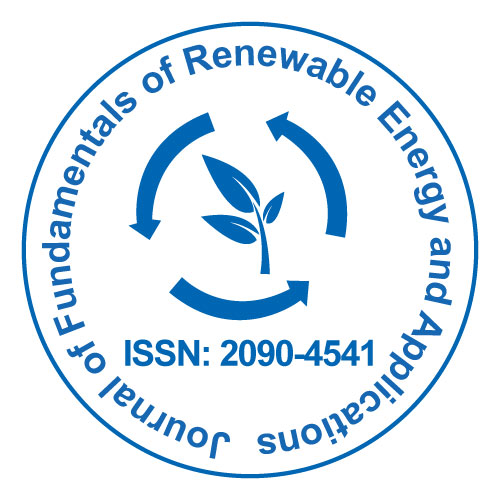
Journal of Fundamentals of Renewable Energy and Applications
Open Access
ISSN: 2090-4541

ISSN: 2090-4541
Opinion Article - (2021)
Renewable energy is derived from renewable resources that are replenished naturally on a human timescale. One of the best renewable energy is solar energy. Non renewable energy sources are exhausted day by day and using fossil fuels to generate energy that produces greenhouse gas emissions and lowers some types of air pollution increasing energy diversity and reducing reliance on imported fuels, manufacturing, installation, and other industries are creating economic development and jobs.
Due to the diminishing supply of renewable energy resources, the last 10 years have become increasingly significant for solar energy gadget per watt cost. It is certain to become more costeffective in the coming years, and to improve as a technology in terms of both cost and applicability. Every day, the earth receives sunlight from above (approximately 1366W). This is an unlimited and free source of energy.
Solar energy has a significant advantage over other traditional power generators in that sunlight may be turned directly into solar energy using the tiniest Photovoltaic (PV) solar cells. There has been a significant amount of research on combining the Sun's energy process by generating solar cells/panels/modules with high converting forms. When compared to the pricing of various fossil fuels and oils during the last ten years, one of the most significant advantages of solar energy is that it is free and available in big amounts. Furthermore, compared to traditional energy production techniques, solar energy requires far less labour [1]. The solar energy is generated by the solar cell, by the advent technology we produce solar energy by the solar cell.
A solar cell (also known as a photovoltaic cell or PV cell) is an electrical device that uses photovoltaic technology to convert light energy into electrical energy. A solar cell is a p-n junction diode in its most basic form. Solar cells are a type of photoelectric cell, which is defined as a device whose electrical characteristics change when exposed to light, such as current, voltage, or resistance. A solar cell is essentially a junction diode, though its construction differs slightly from that of standard p-n junction diodes. On a thicker n-type semiconductor, a very thin layer of p-type semiconductor is grown. On top of the p-type semiconductor layer, we place a few finer electrodes [2].
These electrodes do not hinder the thin p-type layer. Just beneath the p-type layer is a p-n junction. At the bottom of the n-type layer, there is also a current-collecting electrode. We encase the entire unit in thin glass to protect the solar cell from mechanical shock.
When light reaches the p-n junction, photons can readily pass through the thin p-type layer and into the junction. The photons in the light energy supply the junction with enough energy to build a number of electron-hole pairs. The incoming light causes the junction's thermal equilibrium to be broken. The depletion region's free electrons can swiftly reach the n-type side of the junction.
Similarly, the holes in the depletion can quickly come to the ptype side of the junction. Once, the newly created free electrons come to the n-type side, cannot further cross the junction because of barrier potential of the junction.
Similarly, as the freshly generated holes reach the p-type side of the junction, they are no longer able to cross it and have the same barrier potential as the junction [3]. The p-n junction will behave like a small battery cell as the concentration of electrons increases on one side, i.e. the n-type side of the junction, and the concentration of holes increases on the other side, i.e. the p-type side of the junction. A voltage is established, which is referred to as photovoltage. There will be a tiny current flowing through the junction if we connect a small load across it.
Criteria for Materials to be Used in Solar Cell
• There must be a band gap between lev and 1.8ev.
• It should have a high level of optical absorption.
• It ought to be electrically conductive.
• The raw material must be plentiful, and the cost of the material must be reasonable.
Advantages of Solar cell
• It does not cause pollution.
• It should last a long period.
• There are no ongoing costs.
Uses of Solar Generation System
• It can be used to charge batteries, for example.
• It is found in light metres.
• Calculators and wristwatches are powered by it.
• It can be utilised to give electrical energy in spacecraft.
Though solar cells have several drawbacks, these drawbacks are likely to be solved as technology progresses. As technology advances, the cost of solar plates, as well as the cost of installation, will fall, allowing anybody to attempt to install the system. Furthermore, the government is putting a lot of focus on solar energy, so we may predict that in a few years, every residence and every electrical system will be powered by solar or renewable energy.
Citation: Wang G (2021) A Brief Description on Solar Cell and its Criteria of Use. J Fundam Renewable Energy Appl. S2:005.
Received: 03-Dec-2021 Accepted: 17-Dec-2021 Published: 24-Dec-2021
Copyright: © 2021 Wang G. This is an open-access article distributed under the terms of the Creative Commons Attribution License, which permits unrestricted use, distribution, and reproduction in any medium, provided the original author and source are credited.